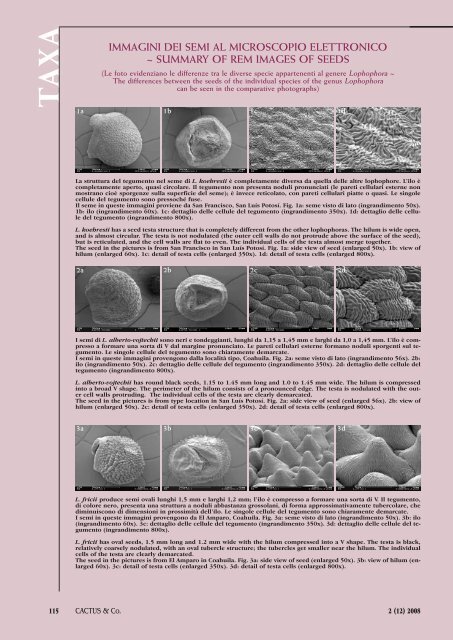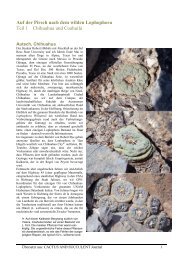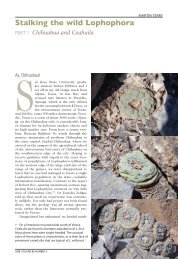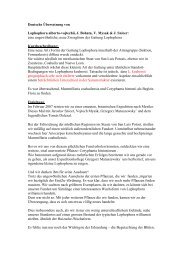alberto-vojtechii - Lophophora.info
alberto-vojtechii - Lophophora.info
alberto-vojtechii - Lophophora.info
You also want an ePaper? Increase the reach of your titles
YUMPU automatically turns print PDFs into web optimized ePapers that Google loves.
TAXA<br />
IMMAGINI DEI SEMI AL MICROSCOPIO ELETTRONICO<br />
~ SUMMARY OF REM IMAGES OF SEEDS<br />
(Le foto evidenziano le differenze tra le diverse specie appartenenti al genere <strong>Lophophora</strong> ~<br />
The differences between the seeds of the individual species of the genus <strong>Lophophora</strong><br />
can be seen in the comparative photographs)<br />
1a 1b 1c 1d<br />
La struttura del tegumento nel seme di L. koehresii è completamente diversa da quella delle altre lophophore. L’ilo è<br />
completamente aperto, quasi circolare. Il tegumento non presenta noduli pronunciati (le pareti cellulari esterne non<br />
mostrano cioè sporgenze sulla superficie del seme); è invece reticolato, con pareti cellulari piatte o quasi. Le singole<br />
cellule del tegumento sono pressoché fuse.<br />
Il seme in queste immagini proviene da San Francisco, San Luís Potosí. Fig. 1a: seme visto di lato (ingrandimento 50x).<br />
1b: ilo (ingrandimento 60x). 1c: dettaglio delle cellule del tegumento (ingrandimento 350x). 1d: dettaglio delle cellule<br />
del tegumento (ingrandimento 800x).<br />
L. koehresii has a seed testa structure that is completely different from the other lophophoras. The hilum is wide open,<br />
and is almost circular. The testa is not nodulated (the outer cell walls do not protrude above the surface of the seed),<br />
but is reticulated, and the cell walls are flat to even. The individual cells of the testa almost merge together.<br />
The seed in the pictures is from San Francisco in San Luís Potosí. Fig. 1a: side view of seed (enlarged 50x). 1b: view of<br />
hilum (enlarged 60x). 1c: detail of testa cells (enlarged 350x). 1d: detail of testa cells (enlarged 800x).<br />
2a 2b 2c 2d<br />
I semi di L. <strong>alberto</strong>-<strong>vojtechii</strong> sono neri e tondeggianti, lunghi da 1,15 a 1,45 mm e larghi da 1,0 a 1,45 mm. L’ilo è compresso<br />
a formare una sorta di V dal margine pronunciato. Le pareti cellulari esterne formano noduli sporgenti sul tegumento.<br />
Le singole cellule del tegumento sono chiaramente demarcate.<br />
I semi in queste immagini provengono dalla località tipo, Coahuila. Fig. 2a: seme visto di lato (ingrandimento 56x). 2b:<br />
ilo (ingrandimento 50x). 2c: dettaglio delle cellule del tegumento (ingrandimento 350x). 2d: dettaglio delle cellule del<br />
tegumento (ingrandimento 800x).<br />
L. <strong>alberto</strong>-<strong>vojtechii</strong> has round black seeds, 1.15 to 1.45 mm long and 1.0 to 1.45 mm wide. The hilum is compressed<br />
into a broad V shape. The perimeter of the hilum consists of a pronounced edge. The testa is nodulated with the outer<br />
cell walls protruding. The individual cells of the testa are clearly demarcated.<br />
The seed in the pictures is from type location in San Luís Potosí. Fig. 2a: side view of seed (enlarged 56x). 2b: view of<br />
hilum (enlarged 50x). 2c: detail of testa cells (enlarged 350x). 2d: detail of testa cells (enlarged 800x).<br />
3a 3b 3c 3d<br />
L. fricii produce semi ovali lunghi 1,5 mm e larghi 1,2 mm; l’ilo è compresso a formare una sorta di V. Il tegumento,<br />
di colore nero, presenta una struttura a noduli abbastanza grossolani, di forma approssimativamente tubercolare, che<br />
diminuiscono di dimensioni in prossimità dell’ilo. Le singole cellule del tegumento sono chiaramente demarcate.<br />
I semi in queste immagini provengono da El Amparo, Coahuila. Fig. 3a: seme visto di lato (ingrandimento 50x). 3b: ilo<br />
(ingrandimento 60x). 3c: dettaglio delle cellule del tegumento (ingrandimento 350x). 3d: dettaglio delle cellule del tegumento<br />
(ingrandimento 800x).<br />
L. fricii has oval seeds, 1.5 mm long and 1.2 mm wide with the hilum compressed into a V shape. The testa is black,<br />
relatively coarsely nodulated, with an oval tubercle structure; the tubercles get smaller near the hilum. The individual<br />
cells of the testa are clearly demarcated.<br />
The seed in the pictures is from El Amparo in Coahuila. Fig. 3a: side view of seed (enlarged 50x). 3b: view of hilum (enlarged<br />
60x). 3c: detail of testa cells (enlarged 350x). 3d: detail of testa cells (enlarged 800x).<br />
115 CACTUS & Co. 2 (12) 2008







